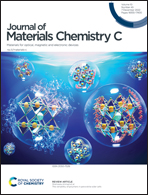Regulation of oxygen vacancy on behaviors of memristors based on amorphous ZnTiSnO films†
Abstract
Amorphous oxide-based memristors are significant candidates for the realization of neuromorphic systems. However, barely attributing memristive performance to oxygen vacancy is insufficient and oversimplified. In this work, the amorphous structure stability, surface morphology and chemical state of amorphous ZnTiSnO films with different oxygen vacancy contents are comprehensively characterized. The memristive performance of Au/ZnTiSnO/Au crossbar devices is sensitive to the oxygen vacancy content affected by the oxygen pressure during functional layer deposition. The device prepared under 4.4 Pa oxygen pressure achieved far more pinched hysteresis loops than that fabricated at 4.5 Pa oxygen pressure. In contrast, no memristive behavior could be observed for devices prepared at 1.8 Pa and 0 Pa. Notably, the content of OII components representing oxygen vacancies differs by less than 10% between samples. An initial low resistance state is observed owing to the Fermi level above the conduction band. For the 4.4 Pa device, there is a narrow difference between the conduction band minimum and the Fermi level, accompanied by high Schottky barriers. These findings provide new inspiration for the design of valence change mechanism memristors.



 Please wait while we load your content...
Please wait while we load your content...